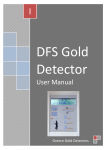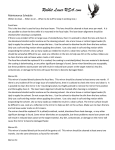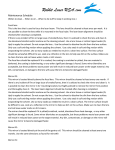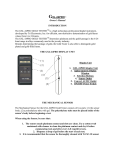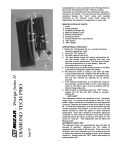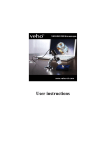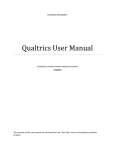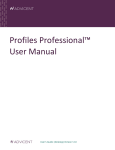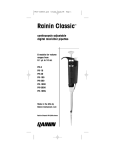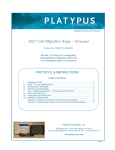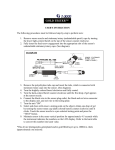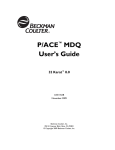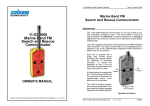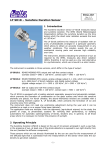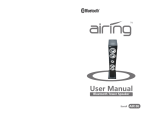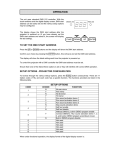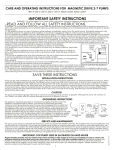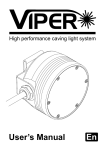Download R S MIZAR, INC. - Oris Nelson Enterprise, INC.
Transcript
RS MIZAR, INC. THE GOLD TEST EXPERTS M24 OWNERS MANUAL IMPORTANT WARNING BEFORE USING PROFESSIONAL MODEL M24, READ ALL INSTRUCTIONS AND SAFETY DATA AT THE END OF THE DOCUMENT. This manual covers the operation of the M24 Electronic Gold Tester. RS MIZAR, INC. has been issued two Patents for its development on the M24 full range Gold Tester. This new process gives accurate and non-destructive test results all the way to 24K gold. It can help determine Gold Karat value in as little as 2 seconds. This process can distinguish non-gold and gold plate from true “Karat Gold” without the destructive Fire Assay testing, which would change the value of the jewelry. RS Mizar now brings you the fastest and easiest Gold Analyzer for all the trades where jewelry and “Karat Gold” have to be quickly and accurately evaluated. The M24 Gold Tester: U.S. PATENTS 5080766, 5128016 OTHER U.S. AND INTERNATIONAL PATENT RIGHTS PENDING Nov 1999 1 SPECIFICATIONS M24 GOLD TESTER M24 Range: 9, 10, 12, 14, 16, 18, 20, 22, and 24 Karat Automatic Shutoff after each test: Approximately 14 seconds Test times: 2 seconds from 9-14 Karats 2-15 seconds from 16-24 Karats Delay before beginning test: 12 seconds Display time: 12 seconds Gold colors: Yellow, White, Red, Green (see “Gold Composition”) Non-destructive testing Distinguishes Gold Wash and Flash from Solid Gold Can be used to distinguish Gold Plate from Solid Gold (see “Testing for Gold Plate”) Dimensions: Length ....................................................................................... 6.3” Width..........................................................................................4.0” Depth..........................................................................................1.5” Weight: With Battery..................................................................8.0 oz. Operating Temperature: 65° F to 90° F (19° C to 32° C) Battery: One (1) standard 9 Volt 2 CONTENTS OF PACKAGE 1. M24 ELECTRONIC GOLD TESTER 2. ERASER 3. TESTING SOLUTION [No. 1995] 4. OWNERS’ MANUAL 5. ERASER PENCIL OPERATING INSTRUCTIONS OPERATING INSTRUCTIONS FOR TESTING GOLD FROM 20K TO 24K When testing Gold from 9K to18K, go directly to instructions below for 9 to 18 Karat testing. When testing Gold from 20K to 24K, a buildup of test solution on the Reference Gold will have to be removed to obtain the proper results. 3 STEP A - Sharpen the Pencil Eraser and then cut off the end with a sharp knife or razor so that it is flat and round (about .160” or 5/32”). Then place the eraser into the Test Well and firmly rotate back and forth for about four seconds. Then brush debris from the Test Well. This preparation will eliminate the excess buildup on the Reference Gold. For all tests of 20K to 24K Gold do this step of removing excess buildup on the Reference Gold with the sharpened and blade-cut Pencil Eraser. A dirty Eraser tip will not sufficiently clean Test Well. STEP B - Go to “item 1” below. OPERATING INSTRUCTIONS FOR TESTING GOLD FROM 9K TO 18K. ITEM 1 Thoroughly clean immersible area of Test Gold with the Gray Eraser (see “DO’S & DON’TS”, item 5.) Attach Alligator Clip to Test Gold away from immersible area. ITEM 2 Loosen the cap of the Test Solution and have a soft paper towel and some QTIPS handy. ITEM 3 Press “TEST YELLOW GOLD” or “TEST WHITE GOLD” (to match the type of Gold that you are testing) and within two seconds, put three or more drops of Test Solution into the Test Well. Quickly squeeze all of the air out of the Test Solution Bottle and tighten cap firmly. (See “item 6”) ITEM 4 Observe that one of the Karat Value Lights is on. Any Karat Light may be lit; this is determined by a previous test or length of time that the unit has been off. After the Light goes out, (within one second), carefully immerse enough of the Test Gold into the liquid to start the “Testing” Light being careful not to touch the reference Gold at the bottom of the Test Well and being careful not to touch the Alligator Clip to the liquid. Hold the Test Gold without moving it until “TESTING” Light goes off. This will take 2 to 15 seconds, depending on the Karat value of the Test Gold. User should brace the “heel” of his hand on the unit or on the same surface as the unit rests on. When possible, brace the Test Gold on the inside of the Test Well just under the surface of the liquid and be very careful not to touch the Reference Gold at the bottom of the Test Well. It is important that the Test Gold not be moved about in the Test Solution until a reading is obtained. 4 ITEM 5 When “TESTING” Light goes out, remove Test Gold. Read LED Display of Karat Value. Clean Test Gold thoroughly with soft paper towel. Thoroughly wipe the Test Solution from the Test Well using a paper towel followed by a Q-Tip. If re-testing is desired, see “DO’S & DON’TS”, items “8” and “11”. ITEM 6 Check to be sure that there is not excessive air in the bottle and that the cap is tightened firmly. • • • • PRECAUTIONS After testing Gold item, it should be cleaned with a buffing wheel. However, it must be cleaned with the gray eraser before any new test because of the residue left on the Gold from the previous test. Improper of insufficient cleaning of the test Gold before testing can increase the karat value readings. Your unit is operating correctly if occasionally you do get a reading in the next range. This can happen when the karat value of the Gold you are testing is very close to the odd karat value, i.e. 17K, 19K, etc. Your unit is operating correctly when this occurs and indicates the Gold you are testing is very near the in-between value. The excess air must be squeezed out of the test solution bottle between tests or when stored. Squeezing out the excess air keeps the solution fresh. When all of the air cannot be squeezed out it needs to be replaced. In any case, the bottle must be replaced 6 months after first opening! “Un-fresh” test solution can cause the karat readings to go lower by one range. You should always have a fresh bottle of test solution available. Record here the date the bottle was opened:______________________ 5 DO’S & DON’TS 1) Don’t use Testing Solution for more than one test; errors will result. 2) Don’t touch Test Gold or Alligator Clip lead to Reference Gold at bottom of Test Well. If this happens remove liquid and re-do test procedure. 3) Don’t let Alligator Clip touch liquid. 4) Don’t leave liquid in test well. This will void your warranty. 5) Do clean Test Gold before testing if it isn’t bright and shiny. Unclean Gold may result in inaccurate readings. 6) Do keep Gold chains very tight (link to link) during testing. Use the fewest number of links (one if possible) between the Alligator Clip lead and the Gold link to be immersed in to the liquid. Three problems can exist with testing chains: a. There may be dirt or contamination between links that would require intensive cleaning (i.e. ultrasonic) before testing. b. Some chains, especially certain European manufactured chains have a thin nonmetallic coating that must be removed from an area before testing. The eraser pencil may be used to remove this coating. c. When testing chains, remember that the solder often used at the link(s) is of a lower Karat than the rest of the chain. Therefore, avoid testing in that area. 7) Do make sure good contact is achieved between the Test Gold and the Alligator Clip lead. If the object to be tested is too large to fit in the clip lead, simply hold the clip lead lightly against the Test Gold during test. 8) Do always clean the Test Gold with the Gray Eraser before retesting in the same location. Pink eraser can be used but it requires considerably more pressure and effort for accurate readings. 9) Do replace the Testing Solution every 6 months after opening. 10)Do use only within Operating Temperature 65°F-90°F. NOTES 1) In the event the Alligator Clip contacts the testing solution, the Alligator Clip must be rinsed thoroughly with water and dried before using again. 2) WARNING: Eye Hazard -- Read warning label on bottle of Test Solution. 3) IMPORTANT: The Testing solution is sensitive to exposure to air. Minimize the time cap is loose on bottle. 6 TESTING FOR GOLD PLATE INTRODUCTION Probably most of the Gold plated items referred to as “costume jewelry” or “fashion jewelry” contain Gold at the surface, which is no thicker than eight millionths of an inch. Such a Gold plate is referred to as Gold flash. A large percentage of Gold flash is sufficiently thin and/or porous (microscopically) that the M24 Gold Tester will “read through” the plate and indicate “NOT GOLD”. A thicker plate will read as Karat Gold unless a portion of the surface being tested is erased with the eraser pencil or filed to expose the metal underneath. The eraser should be used as first choice since it is easier to use and non-destructive. However, the eraser will not work on thick Gold plate. GENERAL DESCRIPTION OF PROCEDURE To determine that an item is Gold plated “non-Gold”, the user of the M24 Gold Tester must take at least two different readings, one reading of a surface, which has not been erased or filed. The reading of the erased or filed surface will be lower if the metal underneath is not gold. (To be sure the metal underneath is not Palladium, see the section on “TESTING FOR PALLADIUM”.) The M24 Gold Tester will read as “NOT GOLD” if a sufficient area of non-Gold is exposed to the liquid but the un-erased or un-filed Gold plate exposed to the liquid does have some effect on the reading, this is why point 2 of the following section under “PRECAUTIONS” is important. When testing for heavy Gold plate, it may be necessary to use a fast drying lacquer or material such as a clear fingernail polish. The area to be tested must be coated with the lacquer and allowed to dry. Next, make a file mark in the center of the coating deep enough to expose the base metal. Then test the exposed base metal with the M24 Gold Tester. Do not allow the Testing Solution to touch any part of the Gold that has not been coated. 7 PRECAUTIONS 1) When testing the un-erased or un-filed portion, be sure that the test area has been relatively unaffected by wear. Flat or thin Gold plated items will tend to be worn at the edges. If it is difficult not to expose a worn area when testing an un-erased or un-filed area, the user may wish to selectively mask any area in question with fast drying lacquer. The reason for masking a worn surface is that if you test a worn surface first, you may obtain the lower Karat reading before any erasing or filing has been accomplished. You, therefore, may not get a lower Karat value on your second test and not be able to determine that you are testing Gold plate. 2) When testing the erased or filed portion, be sure that enough of the surface area immersed in the liquid is erased or filed down to expose the suspected “base metal” underneath. MORE DATA ON TESTING FOR GOLD PLATE The vast majority of Gold plate is 22K or better. Most Gold plated jewelry is flash Gold plate and most flash Gold plate is less than 5 millions of an inch (1/8 micron). The M24 Gold Tester will read right through the 22K Gold plate and indicate anywhere from not Gold to 12 K Gold. Any time you get a 12K or lower reading, Gold plating should be suspected. To determine Gold plate simply use the gray flat eraser on the test sight and then inspect for the presence of base metal. In addition, inspect the Gold color of items reading 9-12 K Gold. If they are really 9-12 K they would not have that “rich” color of a 22K Gold plated item. FINAL POINT It is strongly recommended that users of the M24 Gold Tester practice testing for Gold plate on a few items believed or known to be Gold plated. A few sets of practice runs described under “General Description of Procedure” will impart confidence to the point that the user will find testing for Gold plate to be fast and easy. 8 GOLD COMPOSITION There are four basic colors of Gold: 1) Yellow..................................................................most common 2) White....................................................................second most common 3) Red(Pink/Rose)...........................................……..uncommon 4) Green....................................................................very uncommon The colors are obtained by the use of two or more varied quantities of base metals. These base metals are Silver, Copper, Zinc, and Nickel. Not only are there four basic colors but each color can and does vary the percentages of the base metals. As such, there is no specific formula for each color of Gold. This makes for a range of readings in each color plus a variation of each color at any specific Karat mixture. The M24 Gold Tester can distinguish between Karats of the two popular colors, Yellow and White, by means of color selector buttons. Most red color Gold can be determined by using the White range selector button. Most green color Gold can be determined by using the Yellow range selector button. There are no ranges that are compatible for use on dental Gold alloys. CAUTION: The M24 Gold Tester is a highly accurate, precision instrument for determining Gold Karat values. However, should any disagreement arise with its use, it is recommended that confirmation be obtained with a Fire Assay examination process. This devise, although highly accurate, should be used as a guide to Gold Karat values. The exactness of the device depends on adherence to the instructions provided in this manual and the knowledge of the base metal alloys which are involved. 9 TESTING FOR PLATINUM Platinum is indicated when the test-item reads 22K or higher. That is because white Gold above 18K is virtually non-existent. TESTING FOR PALLADIUM Both Palladium and Platinum will indicate Karat Gold if tested. Platinum jewelry is usually traded at a higher price than Gold jewelry, so Platinum is seldom marked as Gold. Palladium, however, is one-quarter to one-third the price of pure Gold, so it should be noted that pure Palladium may read as medium Karat Gold. Palladium prong settings are sometimes soldered into diamond solitaire White Gold rings. If Palladium is suspected, it is easily distinguished from Gold as nitric acid will quickly turn Palladium dark, Gold is not affected in this way. TABLE OF STANDARDS Karat 24 K 22 K 20 K 18 K 16 K 14 K 12 K 10 K 9K Decimal Gold 1.000 .917 .833 .750 .667 .583 .500 .417 .375 Gold % 100.0 91.7 83.3 75.0 66.7 58.3 50.0 41.7 37.5 Part Per 1000 1000 917 833 750 667 583 500 417 375 MAINTENANCE OF THE M24 The most important step to consistently have accurate results using your gold tester, is the cleaning of the, ”Well & Clip”. Also included with your unit is a standard “Q-Tip”, which is to be used for the cleaning of the well. Do your test as normal, when the test is complete or changing chemical solution use one end of the Q-Tip to absorb the chemical, then use the other end to remove any remaining residue. Dispose of the Q-Tip when complete. Never leave any chemical solution in the well when not testing. If any chemical happens to come in contact with the clip, clean immediately with a clean paper towel. 10 When the “Low Battery” indicator flashes, it is necessary to replace the battery before operating the unit. Simply remove the 4 small screws located under the rubber feet on the rear of the Gold Tester. Carefully remove the rear cover. Locate the 9 Volt Battery and replace with a new one. Replace the rear cover, being very careful not to pinch the wire leads with the cover. Replace 4 rubber feet. TROUBLE SHOOTING GUIDE PROBLEM CAUSE/SOLUTION • “Yellow Gold” or “White Gold” light does not light. • Replace Battery • Low battery light is flashing. • The testing light does not flash • Clean test Gold in area to be tested. • Alligator clip not connected to test Gold. • Reference Gold coated. See note at end of document. • 24 Karat indication for all tests. • Test Gold removed before testing light goes out. • Test Gold or clip being shorted to Reference Gold at bottom of Well. • Misread on high Karats. • Temperature not within 65°F to 90°F. • NOT GOLD reading for all tests. • Alligator clip in liquid during test. 11 SERVICE Before returning unit for service or repairs, you MUST obtain a RETURN MATERIAL AUTHORIZATION (RMA). An RMA may be obtained by writing: TESTING SOLUTION [No. 1995] Replacement of the Testing Solution and Cleaning Solution can be obtained from your supplier or: Oris Nelson Enterprise, Inc. 511 North Indian River Drive Suite: A Fort Pierce, FL 34950 772-429-0045 WARRANTY R S MIZAR provides that each M24 Gold Tester System will be free from defects in material and workmanship for a period of 2 years from the date of purchase. This Warranty becomes void by: 1) Unauthorized repair, misuse, modification, alteration, tampering or breaking any factory seal. 2) Accidental damage, neglect or improper use. 3) Leaving Testing Solution in Test Well. (Battery and solutions are not included in warranty.) R S MIZAR, Inc. shall not be held legally liable or responsible for any error in determining the Gold content of any object using the M24 Gold Tester. 12












